© Copyright JASSS


Nigel Gilbert, Andreas
Pyka and Petra Ahrweiler (2001)
Innovation Networks - A Simulation Approach
Journal of Artificial Societies and Social Simulation
vol. 4, no. 3,
<https://www.jasss.org/4/3/8.html>
To cite articles published in the Journal of Artificial Societies and Social Simulation, please reference the above information and include paragraph numbers if necessary
Received: 10-Sep-00
Accepted: 1-Jun-01
Published: 30-Jun-01
 Abstract
Abstract
-
A multi-agent simulation embodying a theory of innovation networks has been built and used to suggest a number of policy-relevant conclusions. The simulation animates a model of innovation (the successful exploitation of new ideas) and this model is briefly described. Agents in the model representing firms, policy actors, research labs, etc. each have a knowledge base that they use to generate ‘artefacts’ that they hope will be innovations. The success of the artefacts is judged by an oracle that evaluates each artefact using a criterion that is not available to the agents. Agents are able to follow strategies to improve their artefacts either on their own (through incremental improvement or by radical changes), or by seeking partners to contribute additional knowledge.
It is shown though experiments with the model's parameters that it is possible to reproduce qualitatively the characteristics of innovation networks in two sectors: personal and mobile communications and biotechnology.
- Keywords:
- innovation, simulation of social networks, mobile communications, biotechnology, kene
 Introduction
Introduction
- 1.1
- Innovation is increasingly recognized as requiring the convergence of
many sources of knowledge and skill, usually linked in the form of a network. Today, few innovations can be assigned
to a single specific technological field or even a specific firm (e.g. Klein, 1992).
Accordingly, firms cannot expect to keep pace with the development of all relevant technologies without drawing on
external knowledge sources. In this respect, today innovation networks are widely considered as an efficient mean of
industrial organization of complex R&D processes. In most of the recent research on industrial economics and new
innovation theory the increasing complexity of knowledge, the accelerating pace of the creation of knowledge and the
shortening of industry life cycles are considered to be responsible for the rising importance of innovation
networks.[1] Mechanisms of learning and knowledge creation play a decisive role in
the emergence of networks. In this light, networks are to be considered as a component of the emerging knowledge
based society, in which knowledge is crucial for economic growth and competitiveness. In the knowledge based society
not only the quantity of knowledge used is greater but also the mechanisms of knowledge creation and utilization are
changing.
- 1.2
- Although recent work in evolutionary economics and elsewhere has
examined the role of innovation networks in technical change, it has mainly been at the level of description, introducing
for example the concept of national (Nelson, 1993) or regional (Cooke/Morgan, 1994) innovation systems. It has proved difficult to describe
the complex dynamics of innovation networks using conventional methods of analysis (e.g. Pyka, 1999). In this paper, we introduce a simulation approach developed by referring to a
general theoretical model of innovation networks (Gilbert, 1999 and Gilbert, Pyka and Ropella 2000) and two empirically oriented conceptions of actual
innovation networks. We consider innovation networks as evolving from the dynamic and contingent linkage of
heterogeneous units each possessing different bundles of knowledge and skill.
- 1.3
- In order to study these co-evolutionary systems, the Self-Organizing
Innovation Networks (SEIN) project[2] has assembled case studies to provide a
practical cover set for systems of this type (see e.g. Weber/Paul, 1999, Saviotti/Pyka, 1999). The project has two primary foci: i) the empirical investigation
of particular examples drawing on traditional techniques of social science to develop a typology of innovation networks
(Ahrweiler, 1999) and ii) building on this, the development of a simulation platform
for computational experiments in order to investigate the dynamics of technological collaborations and the emergence
of persistent innovation networks.
- 1.4
- To ensure commensurability between the empirically-oriented case
studies and the theoretically-oriented simulation model, we are taking a two-pronged approach: the simulation platform
supports the implementation of an abstract model of an innovation network and also constitutes the overall framework
for the application of the specific case studies. This paper deals with the design of the platform and its application to the
Biotechnology and the telecommunications sector.
 Innovation networks
Innovation networks
- 2.1
- In an influential monograph, Gibbons et al. (1994) argued that knowledge production is in the process of changing from its 'traditional'
locus in the ivory towers of academe to being much more closely connected with application contexts. Knowledge
production in "Mode 2" is non-hierarchical and heterogeneously organised. The organisation of knowledge production
is flexible, fluent and transitory:
Examples of this are numerous environmental and agricultural
matters, diet and health problems, computerised databanks and privacy. Interactions
between science and technology, on the one hand, and social issues on the other have
intensified. The issues are essentially public ones, to be debated in hybrid fora in which
there is no entrance ticket in terms of expertise (Gibbons et al, 1994: 148).
- 2.2
- The economic aspects of innovation have also received increasing
attention. Based on the path-breaking work of Nelson and Winter (1982), the
Schumpeterian research tradition has been merged with organisational and behavioural elements (especially Cyert and March 1963, Simon 1955) within an evolutionary
framework of variation, selection and historical time, in order to capture the dynamics of innovation and their impact
on growth, trade and technological change (cf. Dosi et al. 1988). One of the major
motivations behind this work was a discontent with the lack of explanatory power of neo-classical economics in
dealing with issues of technological change. In evolutionary economics, the technological element is captured in
notions such as 'technological trajectories', i.e. distinct paths of technological development which dominate others and
become selected. Several mechanisms have been identified which lead to the establishment of such trajectories.
Prominent among these are the mental framework of scientists and engineers, labelled by Dosi (1982) as 'technological paradigms' (cf. Sahal 1985, Nelson 1987). Other important mechanisms are the persistence of established technological
and economic structures or 'lock-ins' into certain technological pathways as a result of a reinforcement of minor
comparative advantages or network externalities. In organisational and behavioural terms, evolutionary economics
departs from the notion of profit-maximising agents and adopts the concept of 'routines' to describe decision-making
processes.
- 2.3
- While the earlier work of Nelson and Winter emphasises the market as
the main selection environment for technologies, later contributions from a systems perspective pursue a wider
approach, and focus on institutional elements as constraining the decision behaviour regarding innovations. Such
'systems of innovation' have been identified, especially at national (cf. Lundvall 1992,
Nelson 1993), but also at regional levels (cf. Morgan 1997).
Within this system context, learning processes among actors are regarded as being crucial, especially those between the
users and suppliers and between competitors. From an evolutionary perspective, longer-term, paradigmatic changes in
knowledge production are caused by changing patterns of selection in different social spheres: science and technology
development, economic development, social changes, institutional factors, and mental frameworks.
- 2.4
- The contributions of the sociological literature on innovation and
industry dynamics complements the work of evolutionary economics at the micro-level. Network analysis has revealed
that new technological innovations are often a 'social construct' rather than or in addition to emanating from scientific
and technological advances. Network relationships, which complement traditional markets and hierarchies, have
become more and more important for the production of knowledge. Systematic efforts using concepts such as 'actor
networks' (Callon 1992) or 'socio-technical constituencies' (Molina 1993) have provided initial, if rather static analyses, but do not allow one to study
and understand the dynamic behaviour of innovation networks.
- 2.5
- Empirical research on the impact of policy measures, especially of
regulation, has confirmed the important role played by the political realm in innovation processes. Recent work on
policy networks has demonstrated the importance of close interactions between policy-makers and technology-makers
for shaping the institutional and political environment of innovation processes (see, for example, Marin and Mayntz 1991, Mayntz and Scharpf 1995). It
recognises the need to look at actor constellations that shape the outcome of policy making processes, and at the
interdependencies between institutional change and actor strategies.
- 2.6
- In sum, the economic, sociological and policy literatures have begun to
demonstrate that recent developments in knowledge production can usefully be conceptualised in terms of innovation
networks. Nevertheless, they still leave several basic questions unanswered. There is no clear definition of what an
innovation network is. Rather there are numerous specifications, each emphasising different aspects depending on the
perspective of the proposer. Secondly, it is not clear whether there is a single phenomenon applicable to all spheres of
innovation, or disparate processes with little or no commonality. Do the innovation networks in biotechnology have
the same characteristics as those in telecommunications? Is it useful to treat the processes of knowledge production in
the two sectors as similar? Thirdly, the literature is rather silent about the dynamics of innovation networks: how they
arise, the growth processes they undergo, and the way they die or merge into other networks.
- 2.7
- It is therefore necessary to begin to elaborate a theory of what
constitutes an innovation network, together with its dynamics. In this paper we make a start by developing a simulation
model of a 'generic' innovation network. The role of simulation in this context is not to create a facsimile of any
particular innovation network that could be used for prediction, but to use simulation to assist in the exploration of the
consequences of various assumptions and initial conditions, that is, to use simulation as a tool for the refinement of
theory. The first part of this paper is concerned with the development of an abstract simulation model that could
constitute a dynamic theory of innovation networks. In the second part of the paper, we apply this model to the
particular cases of biotechnology and telecommunications to show how the generic theory can be used to illuminate
innovation in specific sectors.
- 2.8
- The methodology we have adopted accords with Axelrod's (1997) description of the value of simulation:
Simulation is a third way of doing science. Like deduction, it starts with a
set of explicit assumptions. But unlike deduction, it does not prove theorems. Instead a
simulation generates data that can be analyzed inductively. Unlike typical induction,
however, the simulated data comes from a rigorously specified set of rules rather than
direct measurement of the real world. While induction can be used to find patterns in
data, and deduction can be used to find consequences of assumptions, simulation
modeling can be used to aid intuition (Axelrod, 1997:
24-5)
 Description of the Model
Description of the Model
- 3.1
- The following description of the model is given in a very general form
because the simulation platform can be applied to different contexts, in particular the four different case studies of the
SEIN project, and can be used to emphasise different perspectives e.g. an economic or sociological perspective on the
evolution of innovation networks.
Actors
- 3.2
- The starting point for our conceptualisation of an innovation network is
the actors. These are mainly firms engaged in research and development (R&D). In addition, there are also political
actors, venture capitalists, and universities and public research institutes that bridge the gap between applied and basic
research.
- 3.3
- Actors are represented as code that has the standard attributes of
intelligent agents (Wooldridge and Jennings 1995):
- autonomy (operating without other agents having direct control of their actions and internal state)
- social ability (able to interact with other agents)
- reactivity (able to perceive their environment and respond to it)
- proactivity (able to take the initiative, engaging in goal-directed behaviour)
.
- 3.4
- The actors in the simulation are able to learn from their own endeavours
in research and from other actors with which they collaborate.
Kenes
- 3.5
- For the representation of actors we draw on a genetic description
following the concept of kenes (Gilbert 1997). A kene of an actor i (i ∈ {1, ...,
k}) is a collection of technological capabilities Cji in different technological fields (j ∈ {1, ..., l}) measured in nominal
values where the actor has a certain ability Aj,mi (m ∈ {1,..., p}) also measured in nominal values describing its
particular specialisation. For each ability the actors develop an expertise level Ej,mi which is a cardinal value measuring
the agents' command of the respective ability.
- 3.6
- Generally, there are large number of capabilities, each of which
represents a major technological strand, for example, combinatorial chemistry or bio-informatics in the biotechnology
case study., There are only small number of different abilities for each capability, each of which stands for the specific
technological trajectory a particular actor is following. Drawing again on the biotechnology case study, two abilities of
the combinatorial chemistry capability are serial synthesis and high-throughput screening technologies. The expertise
level describes the particular level of know-how and skill an actor has acquired in a certain ability.
- 3.7
- For example, a specific capability of an actor i in the BioTech case is
represented as the triple: (C2i; A2,mi; E2,mi = 3), where the second capability stands for combinatorial chemistry, the
respective ability m is high-throughput technologies, and the expertise level of the actor is three.
- 3.8
-
The general structure of a kene is a list of triples (Figure 1):
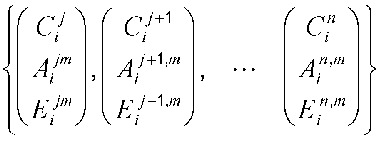
|
|
Figure 1. Kene |
- 3.9
-
During the innovation processes, this list of triples is modified
according to the particular research strategy an actor chooses, as described below. Before discussing the different
strategies available for the actors in the model, we shall introduce the way an innovation can be created from an actor's
kene.
- 3.10
- From the set of triples describing an actor's kene a subset of at least
five triples is randomly chosen to represent the particular research focus of this actor. In other words, actors concentrate
their research in certain directions and therefore have to be selective in the particular research direction they choose.
This subset of triples then is evaluated to give the co-ordinates of a potential innovation, its innovation hypothesis. This
process is illustrated in Figure 2, where the five grey shaded triples were chosen in order to construct an actor's
innovation hypothesis.

|
|
Figure 2. From the kene to the innovation hypothesis
|
- 3.11
- Whenever such an innovation hypothesis is created, the expertise
levels Ej,mi of the abilities included in the hypothesis increase by one and the expertise levels of abilities not included
decrease by one. This reflects learning-by-doing as well as learning-by-using in those fields the actors are active in,
whereas the skills in fields the actors are no longer active in depreciate. Finally, if any triple has an expertise level that
has dropped to zero, that triple is deleted from the kene. Figure 3 illustrates this processes of learning and forgetting for
the exemplary kene used above, where we use numbers to represent expertise levels:

|
|
Figure 3. Learning and forgetting represented in expertise levels
|
- 3.12
- The first triple has an expertise level of 1 and is not in the innovation
hypothesis. It is therefore deleted. Triples 6 and 8 are also not in the innovation hypothesis and have their expertise
level reduced. All the other triples are included in the actor's innovation hypothesis and their expertise levels are
increased.
The Innovation Oracle and the entry of new firms
- 3.13
- Innovation hypotheses which, depending on the setting, might
represent a new design, a new drug, new knowledge for which a patent application could be made or a new discovery,
are submitted each period to an institution we label the Innovation Oracle. It can be understood as a map of a
multidimensional and multi-peaked landscape unknown to the actors. The specific co-ordinates of an innovation
hypothesis then determine a point in the landscape. The height of this point indicates the financial reward that can be
gained by this particular innovation. When this reward is above a certain threshold, the Oracle allows the innovation
hypothesis to succeed. The hypothesis is launched as an real innovation and the reward is paid to the innovator. In
order not to provide rewards for the same innovation several times, the landscape is also deformed at and around this
particular point. The reward for the point corresponding to the innovation is decreased while the rewards for the
immediate neighbourhood are slightly increased, making this region attractive for imitation.
- 3.14
- The reward attributed to a successful innovation furthermore signals a
promising context for innovation to potential entrants. When the reward is above a certain threshold, a new actor is
created as a randomly mutated copy of the successful innovator's kene. By this means, fierce competition is introduced
in these regions of the reward landscape. Additionally, an entry process modelled this way supports the diffusion of
economically relevant know-how.
Research Strategies
- 3.15
- The research endeavours of the actors in the model aim at
modifying and improving their kenes in order to discover those parts of the reward landscape which offer at least
satisfying rewards i.e. rewards above the threshold below which innovation hypothesis are rejected by the innovation
Oracle. Actors may be endowed with any of three research strategies. The first is the go-it-alone strategy where
actors engage only in their own R&D and do not collaborate with other actors. The second strategy focuses on imitation
only; firms with this imitative strategy always search for collaboration partners but do not do any research on
their own. And finally we also consider a collective strategy where firms engage in their own research as well
as in collaboration.
- 3.16
- An actor carries out its R&D by incremental research consisting of
modifications and improvements within the set of capabilities it has chosen for its innovation hypothesis. Doing
incremental research does not, therefore, include any major changes in the sense of substituting capabilities of the
innovation hypothesis for capabilities not yet included. Instead, incremental research means exchanging a capability's
ability with another ability not yet tried; in terms of kene triples this is done by replacing an existing ability Aj,mi with a
new one Aj,m+xi chosen from the possible abilities of the triple's capability. The corresponding expertise level of the
changed triple is reset to one (Figure 4).

|
|
Figure 4. Incremental research
|
- 3.17
- The new ability is selected using a simple 'hill-climbing' method of
optimisation: if the ability has previously been changed and the effect was beneficial for the success of the hypothesis,
then continue in the same direction, otherwise select another ability at random. The actors submit their modified
innovation hypotheses to the innovation Oracle and are thus able to venture into new areas of the reward landscape in
order to search for higher payoffs.
- 3.18
- The cost of R&D reduces actors' capital stocks. The only way for
them to refresh their capital stocks is by successfully introducing a further innovation and receiving the corresponding
innovation reward. Actors are also able to choose to do radical research, which means drawing on a new subset of
triples for the innovation hypothesis. In deciding between doing incremental or radical research, actors are guided by
the success of their record of incremental research as well as by the absolute level of their capital stock.
Exit
- 3.19
- The actors leave the simulation when their capital
stocks are reduced to zero. Besides the above mentioned costs of performing R&D and the costs of
cooperation introduced below, an actor's capital stock is also depreciated by a certain amount each
period. Thus every actor has to participate in the innovation process to earn rewards because
otherwise their capital stocks steadily decrease to zero.
Collaboration and Networks
- 3.20
- Those actors whose strategies also include collaboration can
modify their kenes by exchanging knowledge with their cooperation partners. A distinction is made between bilateral
collaborations, consisting of a one shot exchange of knowledge, and networks which aim at long lasting cooperative
relationships and a persistent joint modification and improvement of the actors' kenes. Because networks emerge out of
bilateral collaboration we begin by introducing collaborations.
- 3.21
- At each time step, actors willing to cooperate search for potential
partners. In this search process, the qualities of potential partners are displayed through their 'advertisement', a list of
the capabilities that they have included in their last innovation hypothesis. In selecting a potential partner the actors
remember with whom they previously had a collaboration and generally prefer to renew a collaboration rather than
starting a new one with an actor with whom they have no experience. The attractiveness of a potential collaboration
partner is measured by the number of capabilities they have in common, because the integration of external knowledge
which only has a vague linkage with one's own knowledge is expected to be comparatively more risky and difficult.
- 3.22
- If both the actor and the potential partner agree that a collaboration
would be beneficial, a new partnership is created. As part of the process of forming a partnership, this leads to a
modification of the actors' kenes in the following way. First, all triples from the kene of the collaboration partner are
copied into the actor's kene. If the actor already has a capability that is the same as the capability in the triple copied
from its partner, the ability from the triple with the higher level of expertise is chosen. Furthermore, the expertise level
of the copied triples is set to one in order to reflect the difficulties in integrating external knowledge. Finally, if the
triple is in the partner's innovation hypothesis it is added also to the actor's innovation hypothesis. In order to avoid the
innovation hypothesis getting extremely long, the merged innovation hypothesis is shortened by randomly deleting
capabilities so that it is of a length defined by a normal distribution with a certain mean and standard deviation.
- 3.23
- Creating a partnership involves co-ordination costs, which are,
however, below the costs of performing one's own R&D. The process of knowledge exchange in a bilateral cooperation
is illustrated in Figure 5. The innovation hypothesis of actors i and f are the grey shaded triples. After
creating the partnership with actor f, the expertise levels of all triples that appear in actor i's innovation hypothesis are
increased by one. Both actors are active in the field corresponding to the first triple's capability, but actor i is drawing
on ability Aj,mi with expertise level 1, whereas actor f uses ability Aj,m+xf at the higher expertise level 4. Actor i's ability
is therefore replaced by f's and the expertise level is set to 1. Also triples from actor f now appear in i's kene:
 The triple
The triple  , which was on expertise level 1 and which does not appear in the
innovation hypothesis, becomes obsolete in the period after the partnership was founded. Finally the innovation
hypothesis of actor i is augmented by two new triples taken from the original innovation hypothesis of its collaboration
partner f.
, which was on expertise level 1 and which does not appear in the
innovation hypothesis, becomes obsolete in the period after the partnership was founded. Finally the innovation
hypothesis of actor i is augmented by two new triples taken from the original innovation hypothesis of its collaboration
partner f.

|
|
Figure 5. Knowledge exchange in a bilateral cooperation |
- 3.24
- It follows from this procedure that two actors that create a partnership
will always submit identical innovation hypotheses to the innovation Oracle in the period after they exchanged their
know-how. If the hypothesis results in a successful innovation, the two actors divide the reward between them, in
proportion to their capital stock (so that the richer partner gets the majority of the reward). A partnership is maintained
for a single time step, although it may be recreated by the partners at the beginning of the next time step..
Networks
- 3.25
- Networks can evolve out of partnerships. Networks, in contrast to
partnerships, are persistent and can involve more than two actors. A network therefore has an emergent identity that has
the effect of protecting the network from short-term dissolution and also reduces internal collaboration costs compared
to partnerships. Additionally, networks create certain barriers which prevents them growing too large.
- 3.26
- The network evolution process is modelled as follows: An actor
i that is in a partnership with another actor f with whom it already has had a partnership in the past
invites this actor to become a member of a network. The partner f may accept this invitation if it is not already a
member of another network. This kernel of a network grows if one of its members invites a further actor with whom it
is in a partnership, with whom it has collaborated before and with whom its network partner has had a previous
partnership. Because there is a requirement for this mutual coincidence of preceding partnerships, networks cannot
grow explosively.
- 3.27
- Members of a network can do incremental and radical research and
further collaboration in the same way as other actors. However, they share the results of their incremental research, thus
gaining collectively from the different research activities that they each engage in. The consequence of knowledge
sharing is that all members submit identical innovation hypothesis to the Oracle and divide their rewards in the case of
success. A network will continue so long as it does not have a long run of unsuccessful hypotheses. If it does, the
network dissolves and the actors return to operating individually.
Summary
- 3.28
- Figure 6 summarises the basic structure of the model.
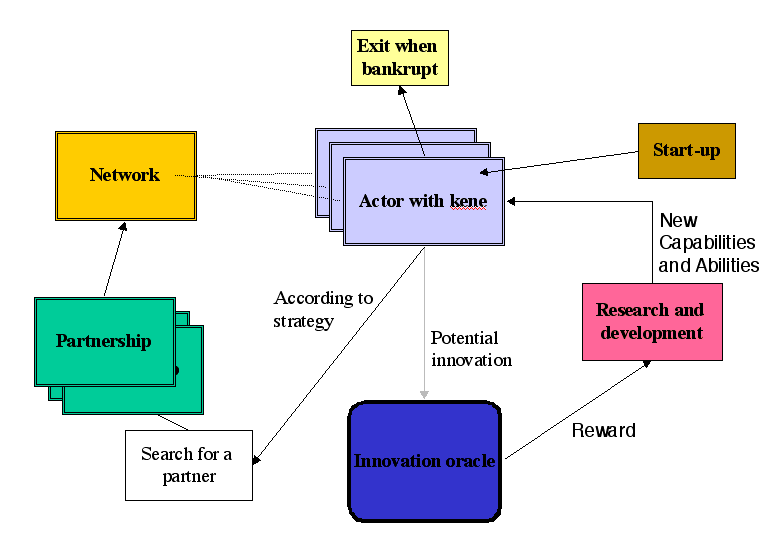
|
|
Figure 6. The structure of the model |
- 3.29
- The kenes of the agents are transformed in case study specific ways
to generate potential innovations that are evaluated by an innovation Oracle to assess whether they are successful
innovations ready to be exploited The actors obtain information from the Oracle to support their decisions about how
to design their future R&D processes. If actors that are willing to collaborate successfully locate a potential partner who
is also willing to cooperate, a partnership is created. From partnerships, persistent innovation networks can evolve
comprising two or more actors. These cooperation processes influences actors' learning, by modifying existing
capabilities and creating new ones. When the innovation is successful, the rewards are distributed according to the case
study specific rewarding mechanism and the rules of the network concerning the distribution of intellectual property
rights, new knowledge etc. The rewards can then be invested in research. An agent that fails to innovate successfully
incurs the costs of research but receives no income and eventually 'dies'.
 Results
Results
- 4.1
- With the model described above we can perform computational
experiments to simulate different innovation networks and their development. We have applied the simulation tool to
three case studies, the Virtual Centre of Excellence in Personal and Mobile Telecommunication (Vaux and Gilbert, 2000) (the VCE case), innovation networks in the biotechnology based
industries (Pyka and Saviotti 2000) (the BioTech case) and innovation networks in
Knowledge Intensive Business Systems in electronic commerce (Windrum 2000) (the
KIBS case). In the following paragraphs the results of the VCE and BioTech simulations are described, while the KIBS
simulation can be found in Ahrweiler, Gilbert, Pyka and Wolkenhauer (2001).
- 4.2
- In the previous section, the basic structure of the model was described
qualitatively. However, to implement the design in computer code, it is necessary to introduce several parameters in
order to differentiate between the case studies. Experimentation with the range of parameters for which the simulation
leads to qualitatively stable results yields a deeper understanding of the model. Moreover, the number and range of
parameters which have to be changed in order to get from one empirical case to the other is of interest. In Table 1 the
parameters of the model are listed for the VCE and the BioTech cases, the grey shaded areas showing where different
parameters are used for modelling the two case studies.
- 4.3
- The most important difference between the two cases is the initial
distributions of actors. In the BioTech case, there are two very different types of actors: first, Large Diversified Firms
(LDFs), for example, the large and established pharmaceutical companies, and second, many small firms which focus
on technological competences, the Dedicated Biotechnology Firms (DBFs). Consequently, the two types of firm are
modelled with different capital stocks, large for the LDFs and relatively small for the DBFs.
- 4.4
- Biotechnology is often characterized as a combinatorial technology
where different strands have to be coordinated in order to develop a new technology. Additionally, a strong
complimentarity between technological and economic capabilities is needed to launch an innovation successfully.
Because of the high degree of technical heterogeneity and the high value of the economic assets required, absorptive
capacities play a much more important role in the BioTech than the VCE case. In order to learn from a cooperation
partner the actors have to share a certain part of their knowledge. The need for a prior shared knowledge base is less
important for the actors in the VCE case.
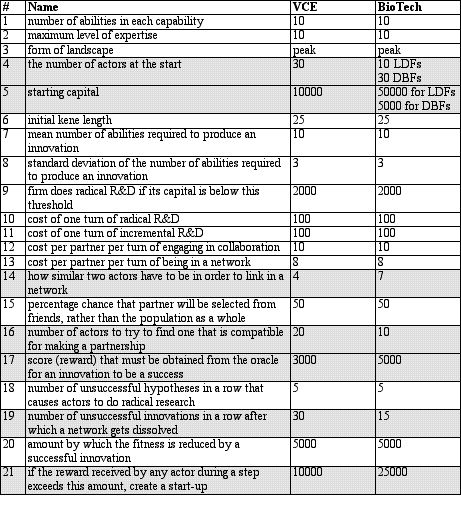
|
|
Table 1.Parameter settings in the VCE case and the BioTech case
|
- 4.5
- Furthermore, the investment required to make an innovation is smaller
in the VCE than the BioTech case. The reason behind this difference can be understood if one considers for example
the pipeline of clinical tests a new pharmaceutical device has to pass before it is permitted to be sold. There is nothing
equivalent in the VCE case. The economic dependence of the firms on their networks is less in the VCE case and
networks dissolve relatively more slowly compared to BioTech, where the actors leave less successful networks more
readily in order to look for other opportunities. Finally, the threshold attracting start ups to enter the market is set higher
in the BioTech case, reflecting the high costs of equipment in this field.
The VCE experiments
- 4.6
- After this brief description of the parameter settings relevant for
the VCE and BioTech cases, we can now introduce the results of the VCE experiments. We know from the empirical
case study that the VCE network includes all relevant actors in the industry and that in the design of the network, policy
actors played an important role. Accordingly, the innovation networks that should develop in the simulation experiment
should be large and stable and contain similar firms with respect to size and technological orientation.
- 4.7
- Figure 7 shows the number of firms (green), the number of firms that
are members of a network (red), the number of firms involved in a partnership (blue) and the number of firms leaving
the area (black). The number of firms is almost constant during the course of the simulation which is close to what is
observed; the small number of exits is compensated by the small number of entries of new firms.

|
|
Figure 7. Number of firms in the VCE experiment |

|
|
Figure 8. Percentage of cooperating firms
|
- 4.8
- The actors engage intensively in partnerships from start, yielding fast
growing networks. This is underlined by Figure 8, which shows the percentage of firms that are engaged in some form
of cooperation. The percentage increases rapidly at the beginning and remains at almost 100 percent. It decreases only
slightly in periods when the smaller networks are dissolved. Because of the intensive partnering activity, the actors
from dissolved networks quickly link to other networks. This also leads to the growth of the average size of a network.
- 4.9
- This simulation run does not finish with one big network, but with four,
one very large and three smaller ones. The reason for this may be a consequence of an important difference between the
simulation and the case study: the omission of an integrating policy actor. The actual development of the VCE network
was influenced significantly by a UK Department of Trade and Industry (DTI) policy initiative that has not been
modelled. Nevertheless, the tendency of the actors to form large networks is clearly demonstrated in this run.
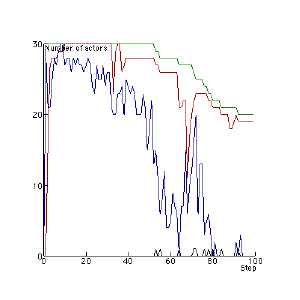
|
|
Figure 9. Another VCE simulation experiment
|
- 4.10
- Figure 9 shows the results of a simulation run that concludes with
only one network. What is the difference with the previous run? In this run, the actors in smaller networks do not
engage in cross-network partnerships. When a smaller network dissolves the actors involved have difficulty in joining
other more successful networks and, if they fail, 'die'. In this run only those actors able to connect themselves to the
large network survive.
- 4.11
- Therefore, we conclude that the evolution of a single network as
found in the VCE case is possible. But without an integrating actor - a policy initiative - such an outcome is not very
likely. However, the networks which emerge spontaneously are large and persistent. This conclusion is also supported
by the growth in the size of firms. Figure 10 shows the development of capital stocks. As the rewards of successful
innovations are shared within the network, the capital stock grows quite steadily. The capital of the largest firm (red) is
not very different from that of the average firm (green). The average is depressed by a small number of new firms
entering with small amounts of capital, shown by the plot of the size of the firm having the least capital (blue). Figure
11 shows the capital stock distribution in the final period (step 100). Most firms are about equal in size.

|
|
Figure 10. Development of capital stocks in the VCE experiment
|
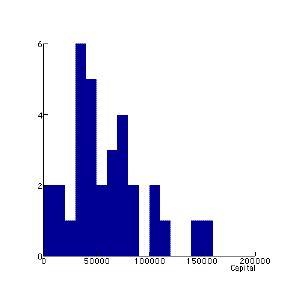
|
|
Figure 11. Final capital stock distribution in the VCE experiment |
- 4.12
- Figure 12 shows the the average (blue) and maximum (red) rewards
for innovations at each time step. In the model, innovation rewards are distributed among the network members
according to firm size. This leads to the two firms that received higher rewards in early periods growing more quickly
than others - a 'success-breeds-success' effect.

|
|
Figure 12. Maximum and average innovation rewards
|
- 4.13
- In early periods a slightly increasing trend in the average rewards is
evident in Figure 12. Knowledge diffuses rapidly among the firms by means of knowledge exchange through networks
and partnerships. Therefore, the actors are able to explore the reward landscape quickly. However, the landscape is
deformed every time an innovation is successful, reducing the rewards of the firms making innovations in that region.
Firms that collaborate with each other increasingly come to resemble one another. The implication is that the overall
knowledge base of innovation networks gradually decreases in heterogeneity, making it more difficult to explore new
regions. Figure 13 shows the gradual decline in the variance of the capabilities over time, a measure of the
heterogeneity of the knowledge of the whole population of firms. So, exchanging knowledge over a long period
reduces the heterogeneity of knowledge assets, ultimately leading to detrimental consequences for novelty and
innovation (Dodgson 1996).
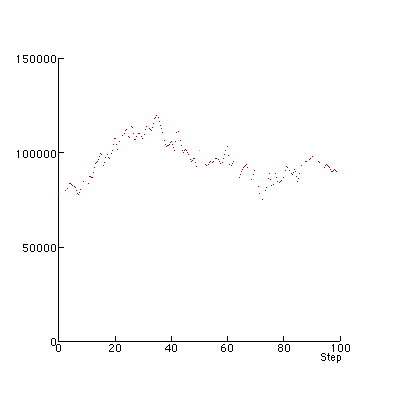
|
|
Figure 13. Variance of knowledge bases in the VCE experiment
|
The BioTech experiments
- 4.14
- In BioTech, networks and partnerships are a means of industrial
organization that is used in a flexible way to get access to new knowledge areas. The development of the industry is
characterized by a high rate of market entries and exits as well as by a very unequal distribution of firms with respect to
size. On the one hand, there are the large pharmaceutical companies and on the other hand there are many small firms
specialized in the new bio-technologies. Many small partnerships and networks are observed.
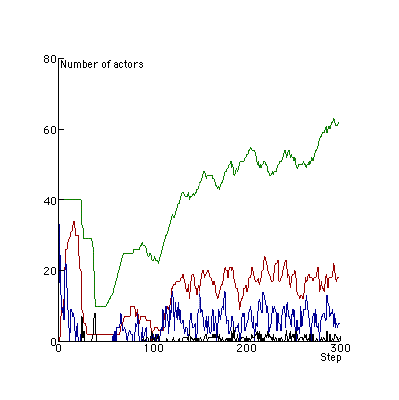
|
|
Figure 14. The number of firms in the BioTech experiments |
- 4.15
- Consequently, the situation to be modelled differs considerably from
the VCE case. Figure 14 shows the number of firms (green). In the first few periods, a shake out of small firms (black)
can be observed. These firms lack the marketing capabilities that play an important complimentary role in the
introduction of innovations and they do not have enough capital to survive without rewards from innovations. This
means that only those small firms that are able to find large firms to be partners (blue) or join a network with a large
firm (red) are able to survive this turbulent early period. The first successes in innovation, at around step 50, triggers
waves of new firms entering the field and these quickly compensate for the loss of firms during the initial shake out.
- 4.16
- Figure 15 shows the final distribution of firms according to their
capital stocks. The unequal distribution is typical of BioTech industries. There are many small actors - the DBFs - and
only a few actors of considerable size - the LDFs.
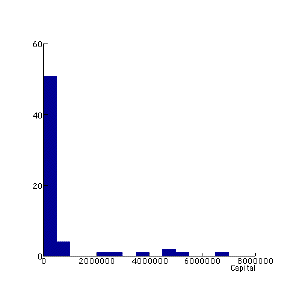
|
|
Figure 15. Final capital stock distribution in the BioTech case
|

|
|
Figure 16. The development of capital stocks in the BioTech experiments
|
- 4.17
- Figure 16 shows the development of capital stocks over time.
Whereas the maximum firm size gets larger and larger (red), the average firm size remains relatively small (green). The
average remains low because of the continuous entry of small firms. The large firms grow even larger because the
innovation rewards earned by networks are distributed proportionately to firm size.
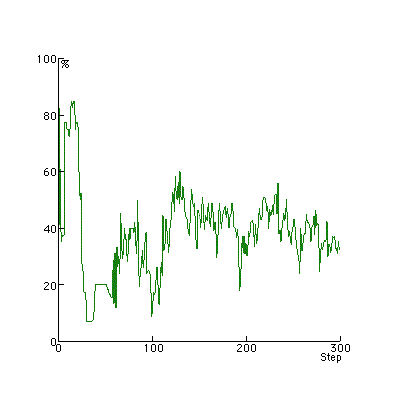
|
|
Figure 17. Percentage of cooperating firms in the BioTech case
|
- 4.18
- A plot of the percentage of cooperating firms, Figure 17, shows a
high level of cooperative activity over the whole period. This can be traced back to the unequal distribution of
economic and technological capabilities in the population, which is also responsible for the first wave of cooperations
(until period 40 or so). However, the development of these collaborations is not accompanied by the successful
introduction of innovations. With the first wave of successfully launched innovations (from period 50 to 75) (Figure
18), a parallel increase in cooperative activity occurs, which is repeated in the later periods.

|
|
Figure 18. Percentage of successful innovations in relation to innovation hypothesis submitted
|
- 4.19
- Figure 18 shows the number of successful innovations as a
percentage of the overall number of innovation hypotheses submitted to innovation Oracle each period. After the early
successes, the actors have to explore new regions in the innovation landscape, which first leads to a decrease in the
proportion of innovation hypotheses that are successful. As soon as they discover a new promising region, they start
exploiting it jointly, and the number of cooperations therefore increases. In another model (Pyka and Saviotti 2000),.we have shown that this can be seen as a change in the role the DBFs
play. In early periods they mainly serve as translators introducing the LDFs to the technological opportunities of
BioTech. With a wider diffusion of BioTech capabilities, however, the cooperative activities do not stop, but now the
DBFs play the role of explorers. This can be seen as a major reason for cooperative activities persisting over time.
Accordingly, we find a moderate increase in both networking and partnership activity (see Figure 14) caused by
positive feedback from innovative success to cooperation.

|
|
Figure 19. Number of firms in another BioTech simulation run
|
- 4.20
- Figure 19 shows the results of another simulation run in which,
compared to the previous run, absorptive capacities play an even stronger role (parameter 14 in Table 1). The firms are
looking for cooperation partners that are very similar with respect to their technological capabilities. This clearly leads
to a slow down in the rate of innovation. The exploration of new promising regions with partners that are quite close to
their own knowledge base becomes relatively more difficult and comparable to the situation in the VCE case where the
rate of innovation decreases after the firms in the network become technologically quite similar as a result of
knowledge exchange over a long period. Hand in hand with this, the number of firms entering (green) declines
considerably. Nevertheless, one feature of the previous run (Figure 14) also occurs here. When successful innovations
are eventually created, we find a twofold positive feedback effect: new firms enter and cooperation increases leading to
an acceleration of innovation and waves of cooperation.
 Conclusions
Conclusions
- 5.1
- The increasing importance of innovation networks
in technical change has been emphasised elsewhere, especially in the evolutionary economics
literature. However, the processes by which networks are formed, and their role in innovation, is
not yet well understood, partly because of the complexity of the dynamic processes involved and
partly because the actors are heterogeneous and therefore hard to model using traditional
techniques. We have shown in this paper how it is possible to approach these issues through the
construction of an agent-based simulation model that allows one to specify, as hypotheses to be
tested, the inter-relationships between new knowledge, knowledge transfer, selection from the
market, and reward structures.
- 5.2
- Our prime focus has been on the development of a conceptual basis and
a theoretical perspective on the dynamics of innovation network formation. Although we have illustrated the model
using two case studies, there remains a great deal yet to be done to test the model adequately. Such testing will involve
two rather different approaches:
- The behaviour of the abstract model itself needs to be explored through a sensitivity analysis that will
reveal the influence of the model structure. For example, we still need to determine more precisely the circumstances
under which the model generates collaborations between actors and therefore yields networks. Under some parameter
settings it is possible for all actors to believe that collaborations would be undesirable, and that they would be more
effective devoting their resources to their own R&D. Alternatively, under other conditions it is possible for all actors to
find the attractions of collaborations to be so strong that the result is a network that includes every actor in the model.
Neither of these scenarios is unrealistic. The model provides the opportunity for exploring the circumstances in which
these and other scenarios are generated.
- The model needs to be specialised to describe the innovation networks in other sectors.
- 5.3
- Finally, it will be possible to draw policy conclusions about the
consequences of fiscal and regulatory changes on the propensity for forming networks to encourage innovation in
different sectors. The model can be used to examine 'What if' questions to see, in a qualitative way, whether proposed
policy changes are likely to have their desired effects.
- 5.4
- By investigating such options, by suggesting new
ideas what to try next and testing their outcome immediately, computer simulation can support the
policy process using various access points to enter the decision and evaluation areas of policy
making (cf. Ahrweiler, Gilbert, Pyka and Wolkenhauer 2001).
However, simulation is not only helpful in creating and supporting policy decisions. It can be also
used to communicate the decisions in a better way. In visualising potential decisions and their
possible outcomes by simulation they become more transparent. Results of decision making can be
illustrated by showing simulation outputs and, crucially, these illustrations can be reproduced and
varied to examine alternatives.
- 5.5
- Thus, the decision process as a whole gains a higher
degree of legitimacy. To work with computer simulation means including modern foresight tools
in the decision makers' armoury: it shows that policy institutions do care for consequences of their
decision making, that they are prepared to react to changed conditions and outcomes of their target
area, and that they search for a way to test and control the quality of their decisions. Using
simulation shows that decision makers make good use of all technical support available.
- 5.6
- Summarising, computer simulation helps to support, communicate and
legitimise the policy decision process. In a way, applying IT techniques to the policy process is an autological operation
which follows the rationale of technology policy itself, namely to strengthen the linkages between science and users.
Here policy makers can apply funded technology to their own area. This feedback or even payback between science
policy and IT simulation research forms the basic mechanism for a self-organising innovation network in the sense of
the SEIN project.
 Notes
Notes
-
1 See e.g. Malerba, F. (1992) and Eliasson, G. (1995).
2 The SEIN project is supported by the European Commission's Framework 4
Programme, contract SOEI-CT-98-1107. We acknowledge the assistance and advice of the other members of the
project.
 References
References
-
AHRWEILER, P. (1999), Towards a General Description of Innovation Networks.
Commonalities and Differences in the SEIN Case Studies, SEIN-Working Paper, #3, September 1999.
AHRWEILER, P., GILBERT, G., PYKA, A., WOLKENHAUER, R. (2001), Tools
and Instruments of the SEIN Evaluation Approach, SEIN-Working-Paper, 2001.
AXELROD, R. (1997)Advancing the art of simulation in the social sciences. In R.
Conte, R. Hegselmann and P.Terna (eds.) Simulating social phenomena, pp. 21-40. Springer-Verlag,
Berlin.
CALLON, M. (1992): The Dynamics of Techno-economic Networks. In: R. Coombs, P.
P. Saviotti and V. Walsh (eds.): Technological Change and Company Strategy. Economic and sociological
perspectives. London: Academic Press, pp. 72-102.
COOKE, P., MORGAN, K. (1994), The Creative Milieu: a Regional Perspective
on Innovation, in: Dodgson, M., Rothwell, M. (eds.), The Handbook of Industrial Innovation, Edward, Elgar,
Aldershot.
CYERT, R. M. AND MARCH, J. G. (1963). A Behavioral Theory of the Firm.
Eaglewood Cliffs, NJ.: Prentice Hall.
DODGSON, M. (1996), Learning, Trust and Interfirm Linkages: Some theoretical
Associations, in: Coombs, R. et al. (eds.), Technological Collaboration in Industrial Innovation, Edward Elgar,
London.
DOSI, G. (1982). Technological Paradigms and Technological Trajectories: A Suggested
Interpretation of the Determinants and Directions of Technological Change. In: Research Policy, 11,
pp.147-162.
DOSI, G., ET AL. (EDS.) (1988): Technical Change and Economic Theory.
London: Pinter.
ELIASSON, G. (1995), General Purpose Technologies, Industrial Competence and
Economic Growth - With special Emphasis on the Diffusion of Advanced Methods of Integrated Production,
Working paper, Royal Institute of Technology, Stockholm.
GIBBONS M., LIMOGES C., NOWOTNY H., SCHWARZTMAN S., SCOTT P.,
TROW M., (1994)The new Production of Knowledge: The Dynamics of Science and Research in
Contemporary Societies, London, Sage Publications.
GILBERT, N. (1997)'A simulation of the structure of academic science' Sociological
Research Online vol. 2(2),
GILBERT, N. (1999), First Draft of a Model of an Innovation Network, SEIN-Working
Paper, June 1999.
GILBERT, N., PYKA, A., ROPELLA, G. (2000), The Development of a Generic
Innovation Network Simulation Platform, SEIN-Working-Paper, #8, 2000.
KLEIN, B. (1992), The Role of Positive Sum Games in Economic Growth, in: Scherer, F.,
Perlman, M. (eds.), Entrepreneurship, Technological Innovation and Economic Growth, Studies in the
Schumpeterian Tradition, University of Michigan Press, Ann Arbor, MA.
LUNDVALL, B. A. (ED.) (1992): National Systems of Innovation. Towards as
Theory of Innovation and Interactive Learning. London: Pinter.
MALERBA, F. (1992), The Organization of the Innovative Process, in: Rosenberg, N.
et al.(eds.), Technology and the Welfare of Nations, Stanford University Press, CA.
MARIN, B. AND MAYNTZ, R. (EDS.) (1991): Policy Networks. Empirical Evidence
and Theoretical Considerations. Frankfurt a.M./Boulder, CO: Campus/Westview.
MAYNTZ, R. AND SCHARPF, F.W. (EDS.) (1995): Gesellschaftliche
Selbstregelung und politische Steuerung. Frankfurt a.M./Bolder/CO: Campus/Westview.
MOLINA, A. (1993): In Search of Insights into the Generation of Techno-Economic
Trends: Micro- and Macro-Constituencies in the Microprocessor Industry. In: Research Policy, 22, pp.
479-506.
MORGAN, K. (1997): The Learning Region: Institutions, Innovation and Regional
Renewal, In: Regional Studies, 31.
NELSON, R.R. (1987): Understanding Technological Change as an Evolutionary
Process. Amsterdam: North Holland.
NELSON, R.R. (ED.) (1993): National Innovation Systems. A Comparative
Analysis. New York: Oxford University Press.
NELSON, R.R. AND WINTER, S.G. (1982): An Evolutionary Theory of Economic
Change. Cambridge/MA: Harvard University Press.
PYKA, A. (1999), Innovation Networks in Economics. From the Incentive-based to the
Knowledge-based Approaches, SEIN-Working Paper <> #1, April 1999.
PYKA, A., SAVIOTTI, P. (2000), Innovation Networks in the Biotechnology-Based
Industries, SEIN-Working Paper #7.
SAHAL, D. (1985): Technology Guide-Posts and Innovation Avenues. In: Research
Policy, 14, pp. 61-82.
SAVIOTTI, P., PYKA, A. (1999), Conceptual Framework for a Simulation Model
of Biotechnology Innovation Networks, SEIN-Working Paper #5, October 1999.
SIMON, H. (1955): A Behavioral Model of Rational Choice. In: Quarterly Journal of
Economics, 69, pp. 99-108.
WEBER M., PAUL S. (1999), Political Forces Shaping the Innovation and
Diffusion of Technologies: an Overview, SEIN-Working Paper, #4, September 1999.
VAUX, J., GILBERT, N. (2000), Innovation Networks by Design: the Case of Mobile
VCE, SEIN-Working-Paper, 2000.
WINDRUM, P. (2000), Modelling technological successions in E-Commerce, SEIN-
Working-Paper, #6, 2000.
WOOLDRIDGE, M. AND JENNINGS, N.R. (1995)Intelligent agents: theory and
practice. Knowledge Engineering Review, 10: 115-152.

 Return to
Contents
of this issue
Return to
Contents
of this issue
© Copyright
Journal of Artificial Societies and Social Simulation,
2001
 Abstract
Abstract![]() Introduction
Introduction![]() Innovation networks
Innovation networks
![]() Description of the Model
Description of the Model




![]() The triple
The triple ![]() , which was on expertise level 1 and which does not appear in the
innovation hypothesis, becomes obsolete in the period after the partnership was founded. Finally the innovation
hypothesis of actor i is augmented by two new triples taken from the original innovation hypothesis of its collaboration
partner f.
, which was on expertise level 1 and which does not appear in the
innovation hypothesis, becomes obsolete in the period after the partnership was founded. Finally the innovation
hypothesis of actor i is augmented by two new triples taken from the original innovation hypothesis of its collaboration
partner f.


![]() Results
Results














![]() Conclusions
Conclusions![]() Notes
Notes![]() References
References![]()
Return to
Contents
of this issue